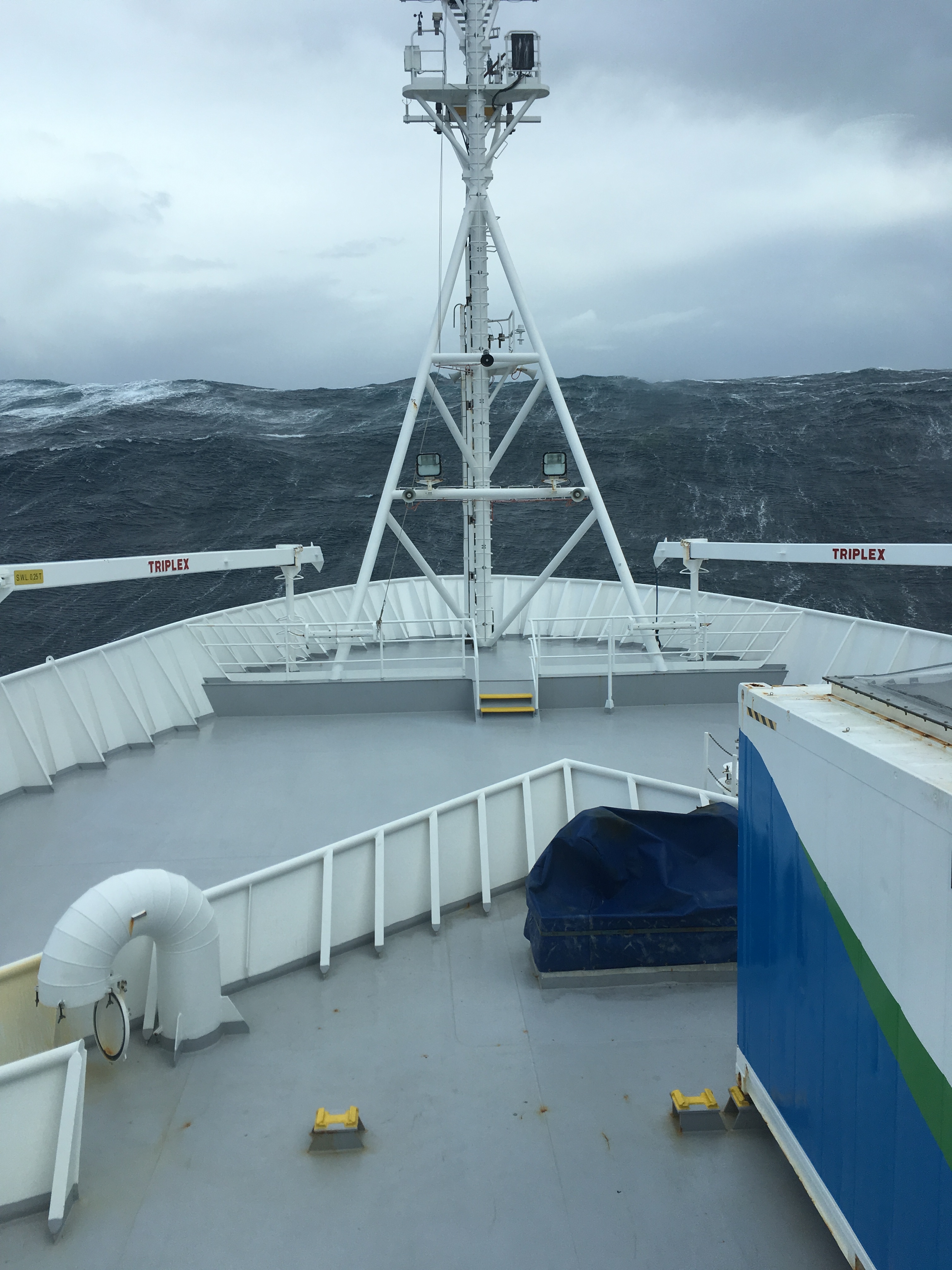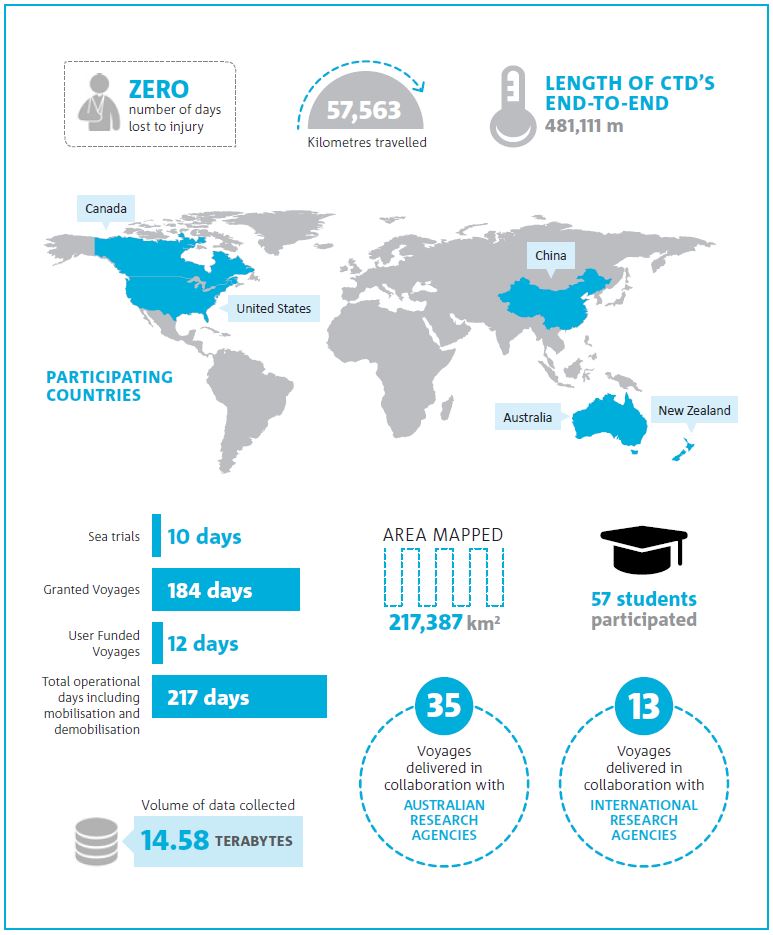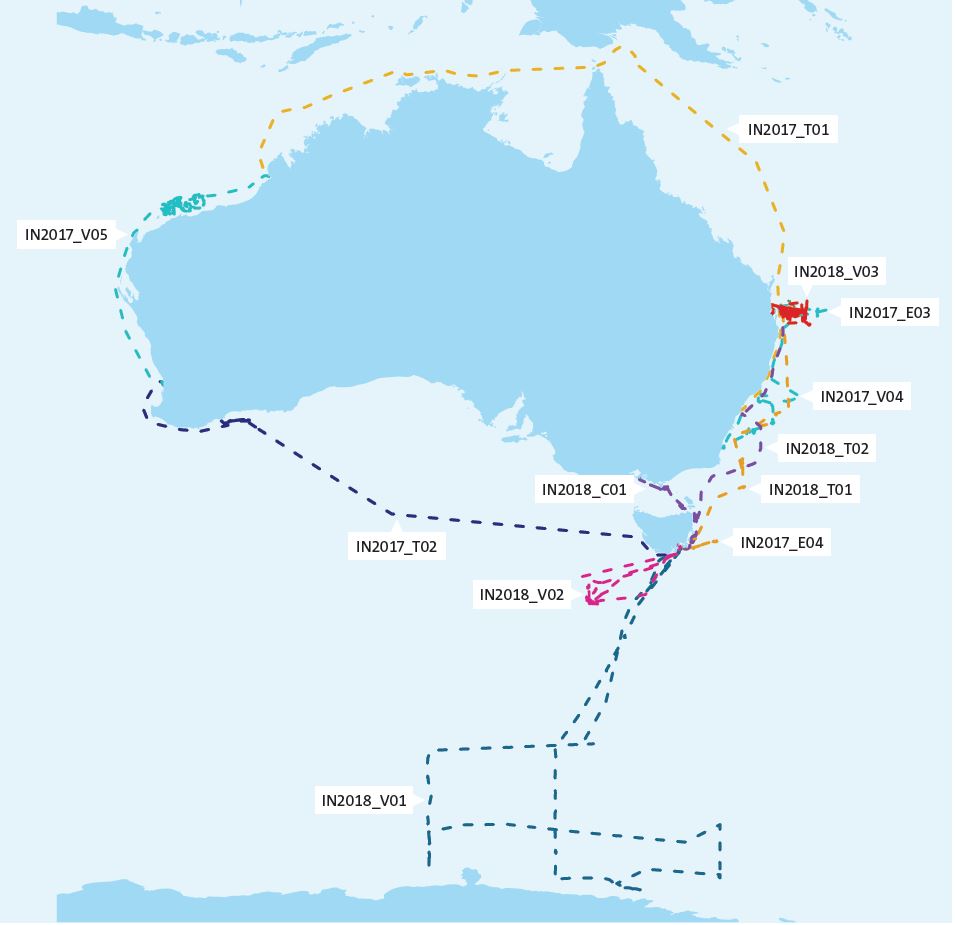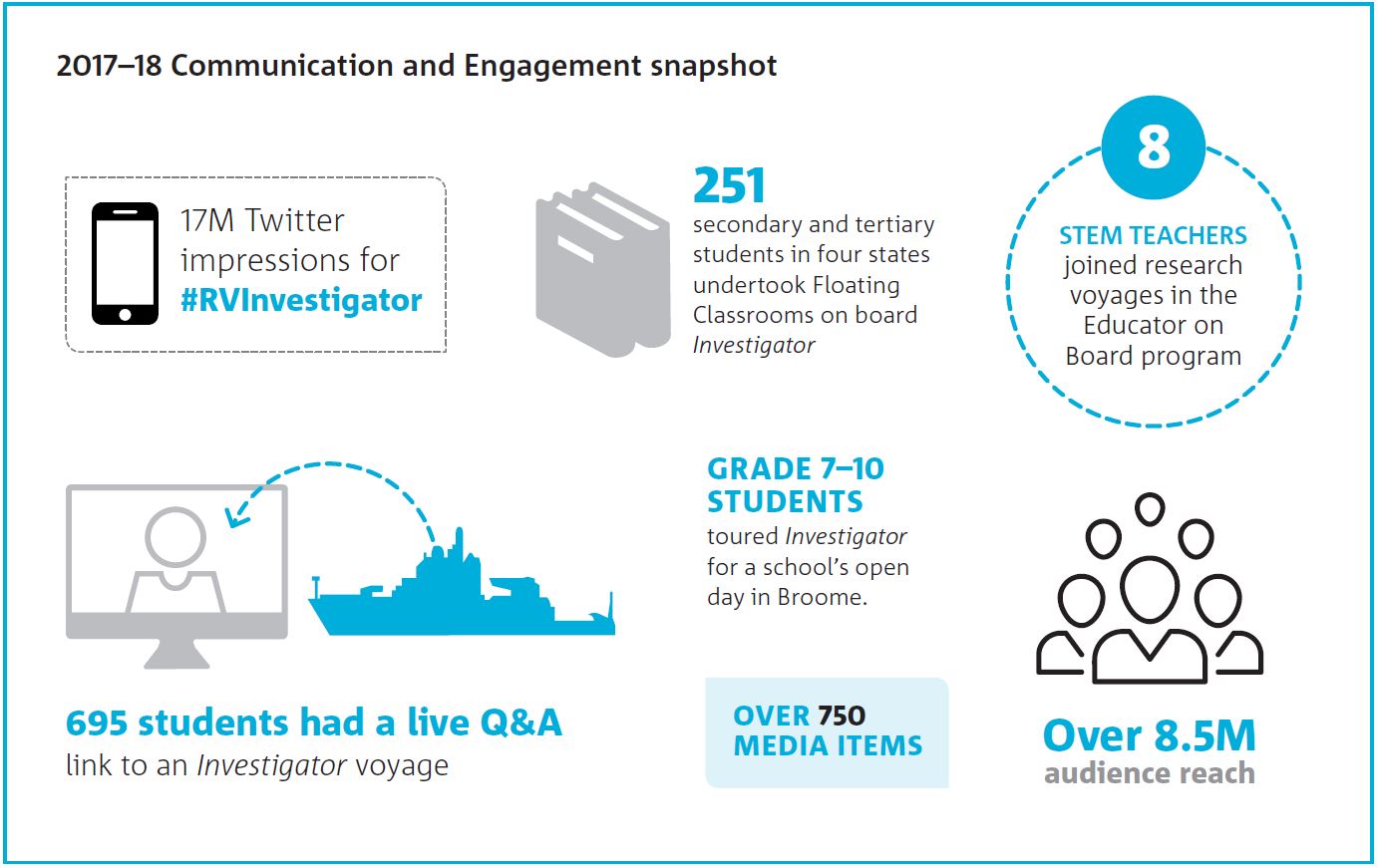Download the Annual Report 2017-18:
Marine National Facility
Annual Report 2017–18
Australia's world-class marine research capability
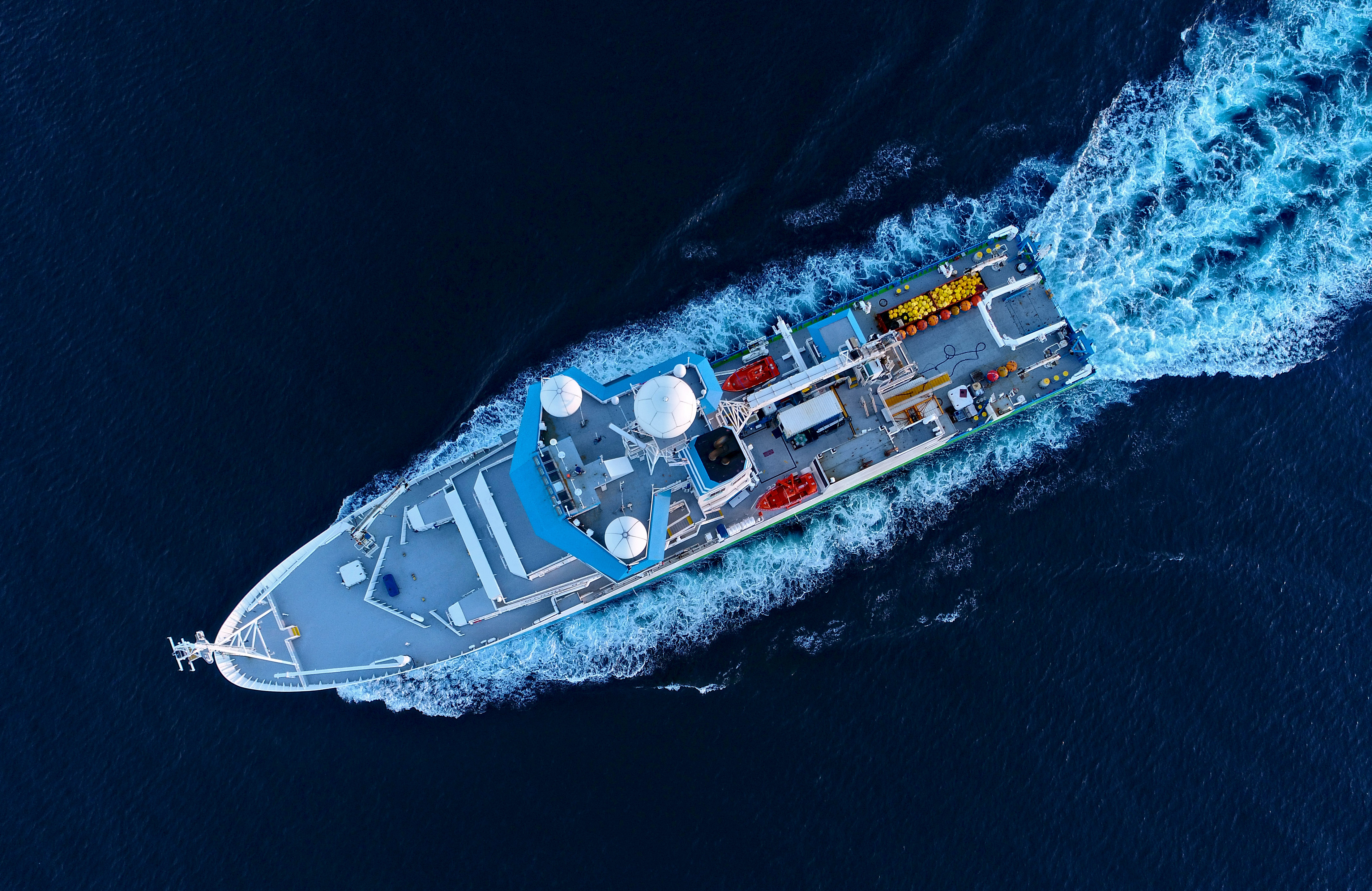 The Marine National Facility (MNF) is a key element of Australia’s research infrastructure. MNF operates the research vessel Investigator to provide a world-class, blue-water research capability for Australian researchers and their international collaborators for work in Australia’s vast and largely unexplored marine areas.
The Marine National Facility (MNF) is a key element of Australia’s research infrastructure. MNF operates the research vessel Investigator to provide a world-class, blue-water research capability for Australian researchers and their international collaborators for work in Australia’s vast and largely unexplored marine areas.
MNF includes the world-class research vessel Investigator, a suite of scientific equipment, staff to support delivery of research voyages and more than 35 years of marine data that are freely available.
Investigator is a multi-disciplinary research vessel capable of servicing the Australian marine science community for approximately 300 days per year. As Australia’s blue-water research capability Investigator can operate from the Antarctic ice edge to the equator supporting and enabling oceanographic, biological, atmospheric and geoscience research.
Grants of sea time are offered through a competitive, independent, peer-reviewed application process focused on scientific and technical excellence, the potential to contribute to Australia’s national benefit and the ability of the research team. Research undertaken through the MNF provides key information to the broader scientific community, government, industry, policy makers and the Australian public. Research data support evidence-based decision-making on challenges affecting regional and global climate, fisheries management, geological resources, coastal and offshore developments, and marine operations.
From the Chairperson, MNF Steering Committee
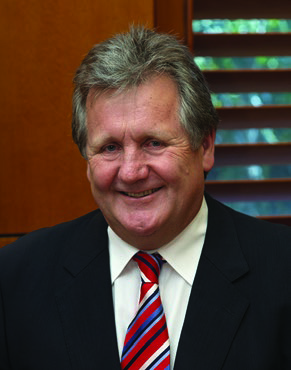
2017–18 saw the MNF deliver a diverse science schedule throughout Australia’s vast marine estate. From the edge of the Antarctic sea ice to the tropics of Australia’s north, and including the Pacific and Indian Oceans, Investigator continues to support and enable multidisciplinary research voyages for the benefit of the nation.
The strategic assessment of applications for sea time is a core function of the MNF. The Scientific Advisory Committee (SAC) and the National Benefit Advisory Panel (NBAP) sat to consider applications for primary granted voyages for 2019–20, with successful applicants awarded their voyages in early 2018. Demand was again strong, with requested sea time far outstripping capacity. The approved schedule will see Investigator operating in the Coral, Arafura and Timor Seas before transiting south for several voyages in the Southern Ocean over the austral summer, then returning north to waters off New South Wales and Queensland. As in previous years, applications for sea time were of an excellent standard and I take the opportunity to thank all applicants for their efforts, the SAC and NBAP for their thorough review and assessment of them, and the MNF staff for their management of the process to finalise this complex voyage schedule.
In response to feedback from proponents, the Steering Committee agreed to changes in the timing of the Granted Voyage application process to better align with the Australian Research Council (ARC) Discovery Project funding scheme. The new process will result in the outcomes of Granted Voyage applications being provided prior to the ARC Discovery Project application closing date, which will benefit applicants by removing the need to submit a speculative application to the ARC where the status of application for a Granted Voyage is unknown.
Achieving full year operations for Investigator has been the highest priority for the Steering Committee for several years, and it is with great delight that I welcome the announcement by the Australian Government of funding under the Research Infrastructure Investment Plan to enable to facility to scale-up to, and maintain, full year operations. This is an exciting outcome and will allow Investigator to expand on the wide range of excellent marine and atmospheric research, monitoring, education and training this vessel enables, and deliver Australia the full benefit from its capability. The Committee wishes to express its sincere thanks to the Australian Government for approving the additional funding and to the marine science community for their unflagging support in achieving this auspicious outcome.
The realisation of full-year operations is testament to the work of the MNF Ships Group and technical staff, and I would like to take this opportunity to thank them for their continued efforts.
Dr Ian Poiner, Chairperson
MNF Steering Committee
From the MNF Director

The 2017–18 voyage schedule saw several milestones for Investigator. The vessel completed its first circumnavigation of the Australian continent, then in February 2018 the ship’s log clocked 100,000 NM. Across the journey over 800 scientists, researchers and technical staff, including over 100 students, from Australia and 15 other countries have stepped on board as part of voyage science teams. These impressive numbers exemplify Investigator’s role as the nation’s dedicated bluewater research capability tasked with supporting and enabling word-class marine and atmospheric science.
The announcement of funding to support full year operations of Investigator is a significant outcome for the marine and atmospheric science community, both nationally and internationally. Scaling-up to deliver complex, multi-disciplinary research voyages year-round brings with it both opportunities and challenges for the MNF. The facility has recently commenced recruitment to fill several positions ensuring the expertise and capability required to continue to deliver high impact, high quality science and the greatest possible benefit to the nation.
In addition to world-leading research, Investigator is an impressive platform to deliver Science, Technology, Engineering and Mathematics (STEM) education and training. As a national facility, the MNF is committed to applied education and training that will contribute toward a pipeline of marine experts who will ensure the prosperity and sustainability of Australia’s marine environments and growing blue economy. 2017 saw the inaugural CAPSTAN (Collaborative Australian Postgraduate Sea Training Alliance Network) voyage sail from Fremantle to Hobart, with 30 students and trainers from 12 universities on board. This dedicated education and training voyage was a great success and the MNF is proud to be supporting three pilot voyages of the CAPSTAN program between 2017 and 2020.
2018 brought the appointment of a new MNF Facilities Program Director and I would like to take this opportunity to congratulate Dr Barbara Musso and welcome her to the MNF family. Dr Musso brings with her a wealth of experience in marine research and management that has already been of significant benefit in the governance, management and operation of the Facility. Finally, I would like to thank Mr Ben Rae, the MNF’s acting Facilities Program Director between 2016 and 2017, who provided invaluable leadership and contribution while we conducted the extensive recruitment process.
Ms Toni Moate
Director, National Collections and Marine Infrastructure
Health, Safety and Environment
The maritime context in which the MNF operates brings unique challenges in the management of health, safety and the environment. The MNF aspires to zero harm and is continuously seeking opportunities to improve systems, procedures and policies designed to ensure the safety of people on and around Investigator. People are at the heart of the MNF’s ability to deliver great science and innovation to our customers.
The interdisciplinary science voyages spanning atmospheric, oceanographic, biological and geoscience research continue to present challenges for the MNF regarding Health, Safety and Environment (HSE). To meet these challenges, the MNF has developed a Voyage Specific Risk Assessment (VSRA) to capture the specific risks and risk mitigation strategies pertaining to each voyage. Examples of strategies implemented from the VSRA include the introduction of a comprehensive hazardous materials risk assessment process and the improving the quality of Safe Work Instructions to align with on-board controls. The hazardous materials risk assessment process ensures agreement on adequate controls for the storage, usage and disposal of all chemicals and gases, prior to departure, by the science teams.
The MNF HSE Committee monitors the statistics relating to HSE and proactively manages improvements, by consultation. The Committee is working on voyage fatigue management and improving mental health and wellbeing at sea for participants, particularly on longer voyages.
No Lost Time Injuries were incurred during the 2017–18 financial year.
| 2016–17 | 2017–18 | |
|---|---|---|
| Lost Time Injury | 0 | 0 |
| Medical Treatment Case | 4 | 1 |
| First Aid Case | 22 | 6 |
| Illness | 5 | 7 |
| Total | 31 | 14 |
Continuous review and improvement initiatives
Voyage Specific Risk Management Plan
The MNF developed a Voyage Specific Risk Management Plan to implement appropriate controls to minimise the diverse risks on each voyage. The plan captures all elements of operations for each voyage individually. It is developed early in the voyage planning process to highlight, and document, all hazards related to the voyage. HSE risk control measures, selected according to the hierarchy of controls, are identified and implemented for all activities undertaken. The plan involves all relevant parties, including voyage team delegates, and allows the MNF to risk assess the entire voyage, not just specific elements. The documented Voyage Specific Risk Management Plan ensures mitigation strategies are continually improved by capturing the controls for a vast range of activities on a Risk Matrix.
2017-18 snapshot
Research delivered and supported
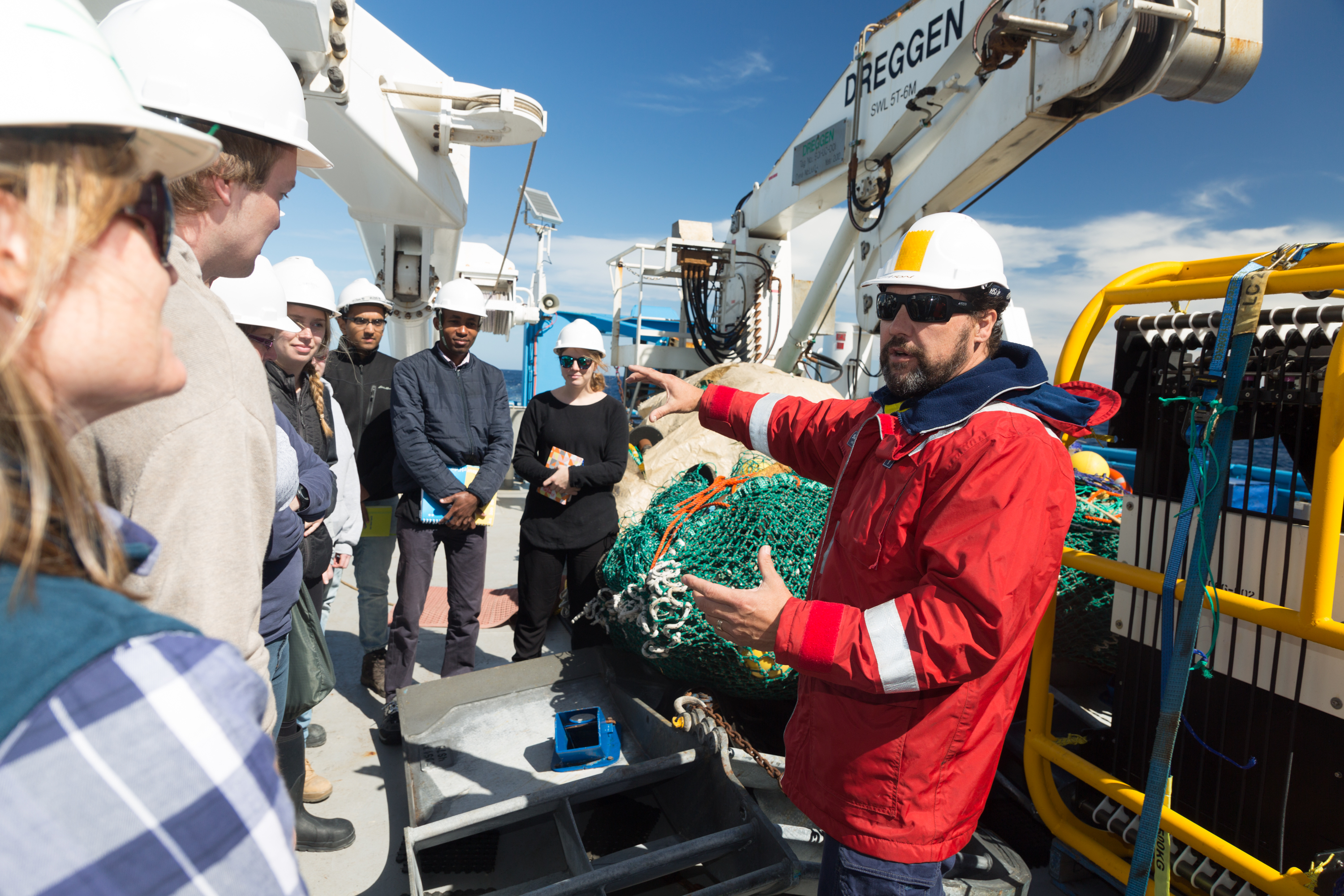
An overview of the MNF voyage schedule for 2017–18 can be found on the MNF website mnf.csiro.au. This includes Voyage Plans, Voyage Summaries and Scientific Highlight reports for each voyage.
The 2017–18 year saw the delivery of an extensive program of multidisciplinary research in all waters around the Australian coastline, as well as a focus on education and training activities that contribute towards developing future workforce and technological capability. Of note, the vessel completed a circumnavigation of Australia during the period, delivering specific research projects but also collecting high quality and quantity data via a range of underway systems. The collection of data via Investigator’s suite of underway systems is vital for contributing to data records for our region, assisting in the validation of environmental models and calibration of remote sensing systems supported such as satellite telemetry. Further, seafloor mapping data collected during every voyage contributes to national programs that are vital for safe navigation and to protect the sovereignty of our marine estate.
Voyages for the period included two biological surveys to increase our knowledge of marine biodiversity and ecosystems in the East Australian Current and North West Shelf. Data collected will contribute both to managing resilient and valuable environments, as well as informing management for food security and quality within both national and international fisheries.
Two voyages were conducted to support the Integrated Marine Observing System (IMOS) moorings project delivered under a multi-year agreement with the MNF. These voyages were conducted to maintain deep-ocean moorings in the East Australian Current and Southern Ocean, assisting in global programs that collect long-term data for monitoring ocean and climate change, as well as validation of environmental modelling.
Further ocean and atmospheric research was undertaken during a 45-day multi-institution voyage to study cloud formation and long-term climatic changes in the Southern Ocean. The range of international partners on this voyage demonstrated the collaborative hub for international research and knowledge exchange that the vessel continues to provide.
Three transit voyages were completed during the period and delivered a diverse range of research, education and training outcomes. Of note, the first transit voyage saw the discovery of the WWII merchant ship SS Macumba, which had been lost for over 70 years. Such discoveries are significant from both a maritime heritage and social perspective and generate significant community interest. The second transit voyage was used to support the inaugural Collaborative Australian Postgraduate Sea Training Alliance Network (CAPSTAN) student training voyage, which contributes towards a pipeline of future marine experts to support Australia’s growing blue economy and marine industries. The final transit saw a wide range of media, education and outreach activities, in addition to a suite of research projects, which help increase general awareness and understanding of our marine environment and the importance of its sustainable management.
One user-funded voyage was conducted for the Australian Hydrographic Office (AHO) to undertake a hydrographic survey in Bass Strait. The opportunistic use of Investigator for seafloor mapping in collaboration with the AHO is part of a whole of government approach to improve navigation charts for the use and benefit of all.
Integrated with the research schedule were two sea trials at the start and one in the middle of the period to test and calibrate new and updated equipment and systems. Sea trials are essential for maintaining the cutting edge capabilities of the vessel.
The schedule concluded with Investigator returning to its home port of Hobart for a period of maintenance.
Voyage Spotlight
North West Shelf trawling study
In October and November 2017, CSIRO’s Oceans and Atmosphere Business Unit led a 26-day research voyage on Investigator to study the longterm recovery of trawled marine communities on the North West Shelf off Western Australia. Forty researchers collaborated on the voyage from eight research institutions including Australia’s WA Fisheries, University of Tasmania, Macquarie University and Museums Victoria, and China’s Ningbo University and Chinese Academy of Sciences. This demonstrates the value of the Marine National Facility as an international collaboration hub for knowledge exchange between scientists and, importantly, between scientists and the public through the communication activities delivered during the voyage.
The Investigator’s significant capability and capacity allowed researchers to set and complete an ambitious program of deployments that delivered a record number of operations carried out on a single voyage. We deployed a wide range of equipment in 584 operations during the 26 days including demersal fish trawl net, epibenthic sled, deep-tow camera, Conductivity, Temperature, and Depth (CTD) sensors, sediment grab and plankton nets.

In total, 100 individual stations were sampled during the voyage. The flexible platform offered by Investigator, combined with expertise of the Marine National Facility and ASP Ship Management technical support staff, enabled reliable data to be collected from all stations. This demonstrates the value of the Facility in delivering highly efficient operations that enable significant volumes of data and samples to be collected, which can be accessed for future analysis and benefit of all.

This voyage will significantly improve our understanding of the long-term recovery of trawled marine habitats and the effectiveness of management responses to protect and enable recovery of impacted ecosystems. The results will be significant in an international context and relevant to the management of trawl fisheries in Australia and overseas.
Communications and engagement
The MNF is committed to educating Australian’s about the research, education and training we delivered in order to demonstrate return on investment and ensure that decision makers at all levels – from individual citizens to government and industry – are well-informed.
The MNF collaborates widely with the ship user community to support the regular delivery of communications, education programs and engagement events that are relevant, accessible and appealing.
Communications spotlight
Discovery of Macumba
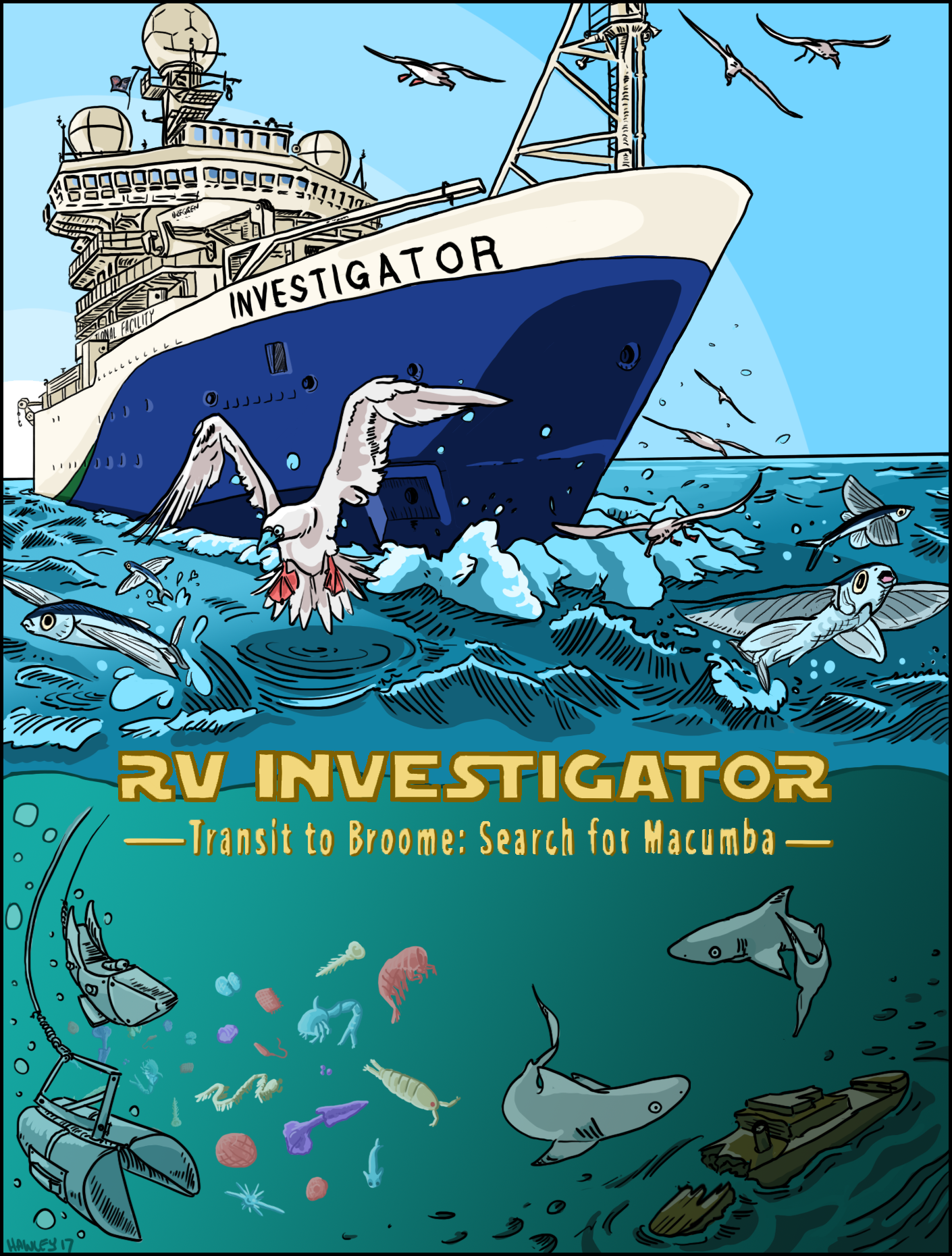 As part of a transit voyage from Sydney to Broome, Investigator was successful in a targeted search for the wreck of SS Macumba, a 2,500-ton steel merchant ship that was sunk on 6 August 1943 when two enemy aircraft attacked at low level and scored a direct hit on the ship’s engine room. Three crewmen were killed as a result of the raid on the Macumba. Second Engineer Harold Keller and Donkeyman George Dew died in the days after the attack, but the body of Chief Engineer William Alfred Lane was never recovered. Other crew members were rescued and taken aboard the escort ship and the Macumba was left to sink to the sea floor. While the location of the attack was known, no previous search had been able to discover the location of the wreck.
As part of a transit voyage from Sydney to Broome, Investigator was successful in a targeted search for the wreck of SS Macumba, a 2,500-ton steel merchant ship that was sunk on 6 August 1943 when two enemy aircraft attacked at low level and scored a direct hit on the ship’s engine room. Three crewmen were killed as a result of the raid on the Macumba. Second Engineer Harold Keller and Donkeyman George Dew died in the days after the attack, but the body of Chief Engineer William Alfred Lane was never recovered. Other crew members were rescued and taken aboard the escort ship and the Macumba was left to sink to the sea floor. While the location of the attack was known, no previous search had been able to discover the location of the wreck.
The discovery of the wreck 74 years later was of significant interest to the public. The voyage received global media coverage providing high visibility of the MNF, Investigator and the work of the research teams on-board to a wide international audience. National media coverage was achieved via TV networks, radio, online and print. Over 200 conventional media items related to discovery with estimated audience reach of over 1.6M.
Data collected by the Investigator and the research team will help form the basis for future protection and management of the historic shipwreck site.
Financial statement
Strong financial management is critical to ensuring the MNF remains viable, effective, and accountable for the expenditure of public funds.
| 2016/17 | 2017/18 | ||
|---|---|---|---|
| $'000 | $'000 | ||
| Revenue | |||
| External Funding |
891 |
677 |
|
| Internal Funding | 31,709 | 25782 | |
| Total Revenue | 32,600 | 26,459 | |
| Expenditure | |||
| Labour | 5,841 | 6,127 | |
| Operating | 24,914 | 19,783 | |
| Total Expenditure | 30,755 | 25,910 | |
| Operating Result | 1,845 | 549 | |
| Capital | |||
| Capital Purchases | 712 | 1,047 | |
Improving our capabilities
Each year, the MNF undertakes a process to identify, prioritise and plan for the acquisition of major items of scientific equipment to support and increase the capability of Investigator for the benefit of our users. This year, the MNF spent $1.047M on science equipment including a Triaxus towed CTD system, weather radar and echosounder calibration system.
Capability case study
Heavy Ocean Towing System

The SIEF provides grants to science and scientists for the purposes of assisting Australian industry, furthering the interests of the Australian community and contributing to the achievement of Australian national objectives. Success via this grants program has supplemented traditional capital funding streams available to the Facility and will enable the MNF to deliver an innovative solution directly in response to user’s feedback who will use the system to further explore the remote and least understood corners of Australia’s deep oceans.
Looking to the future
The Marine National Facility seeks to provide the best possible support to Australia’s marine science community and their collaborators. It also strives to increase engagement with future and early career researchers to grow Australia’s role as a global leader in a broad range of ocean science disciplines.
While representing a long anticipated and very welcome enhancement of resources for Australia’s marine science community, the new funding to achieve full annual operational capacity of the MNF brings challenges that will need careful consideration, these include:
- a need to step-up our safety frameworks to accommodate the reduced margin of error resulting from a significantly increased operational envelope;
- an increased need for operational and technical support requiring a recruitment strategy to address the need to accommodate additional voyages;
- mitigating the implications for efficient scheduling given existing logistical constraints—both facility- and science-driven;
- scaling up the inventory of science equipment, particularly regarding mission-determining equipment, to ensure adequate redundancy.
The MNF has commenced this work, developing a transition plan that shall address these key issues, and others, prior to commencement of the first full-year schedule being delivered in 2018/19. The MNF consider itself well placed to meet these challenges with a high-performance team with many years of experience in delivering successful research voyages for the nation.

FOR FURTHER INFORMATION
Marine National Facility
t +61 3 6232 5596
e mnf@csiro.au
w www.mnf.csiro.au
Download the Annual Report 2017-18:
Marine National Facility
Annual Report 2017–18
Australia's world-class marine research capability
The Marine National Facility (MNF) is a key element of Australia’s research infrastructure. MNF operates the research vessel Investigator to provide a world-class, blue-water research capability for Australian researchers and their international collaborators for work in Australia’s vast and largely unexplored marine areas.
MNF includes the world-class research vessel Investigator, a suite of scientific equipment, staff to support delivery of research voyages and more than 35 years of marine data that are freely available.
Investigator is a multi-disciplinary research vessel capable of servicing the Australian marine science community for approximately 300 days per year. As Australia’s blue-water research capability Investigator can operate from the Antarctic ice edge to the equator supporting and enabling oceanographic, biological, atmospheric and geoscience research.
Grants of sea time are offered through a competitive, independent, peer-reviewed application process focused on scientific and technical excellence, the potential to contribute to Australia’s national benefit and the ability of the research team. Research undertaken through the MNF provides key information to the broader scientific community, government, industry, policy makers and the Australian public. Research data support evidence-based decision-making on challenges affecting regional and global climate, fisheries management, geological resources, coastal and offshore developments, and marine operations.
From the Chairperson, MNF Steering Committee

2017–18 saw the MNF deliver a diverse science schedule throughout Australia’s vast marine estate. From the edge of the Antarctic sea ice to the tropics of Australia’s north, and including the Pacific and Indian Oceans, Investigator continues to support and enable multidisciplinary research voyages for the benefit of the nation.
The strategic assessment of applications for sea time is a core function of the MNF. The Scientific Advisory Committee (SAC) and the National Benefit Advisory Panel (NBAP) sat to consider applications for primary granted voyages for 2019–20, with successful applicants awarded their voyages in early 2018. Demand was again strong, with requested sea time far outstripping capacity. The approved schedule will see Investigator operating in the Coral, Arafura and Timor Seas before transiting south for several voyages in the Southern Ocean over the austral summer, then returning north to waters off New South Wales and Queensland. As in previous years, applications for sea time were of an excellent standard and I take the opportunity to thank all applicants for their efforts, the SAC and NBAP for their thorough review and assessment of them, and the MNF staff for their management of the process to finalise this complex voyage schedule.
In response to feedback from proponents, the Steering Committee agreed to changes in the timing of the Granted Voyage application process to better align with the Australian Research Council (ARC) Discovery Project funding scheme. The new process will result in the outcomes of Granted Voyage applications being provided prior to the ARC Discovery Project application closing date, which will benefit applicants by removing the need to submit a speculative application to the ARC where the status of application for a Granted Voyage is unknown.
Achieving full year operations for Investigator has been the highest priority for the Steering Committee for several years, and it is with great delight that I welcome the announcement by the Australian Government of funding under the Research Infrastructure Investment Plan to enable to facility to scale-up to, and maintain, full year operations. This is an exciting outcome and will allow Investigator to expand on the wide range of excellent marine and atmospheric research, monitoring, education and training this vessel enables, and deliver Australia the full benefit from its capability. The Committee wishes to express its sincere thanks to the Australian Government for approving the additional funding and to the marine science community for their unflagging support in achieving this auspicious outcome.
The realisation of full-year operations is testament to the work of the MNF Ships Group and technical staff, and I would like to take this opportunity to thank them for their continued efforts.
Dr Ian Poiner, Chairperson
MNF Steering Committee
From the MNF Director

The 2017–18 voyage schedule saw several milestones for Investigator. The vessel completed its first circumnavigation of the Australian continent, then in February 2018 the ship’s log clocked 100,000 NM. Across the journey over 800 scientists, researchers and technical staff, including over 100 students, from Australia and 15 other countries have stepped on board as part of voyage science teams. These impressive numbers exemplify Investigator’s role as the nation’s dedicated bluewater research capability tasked with supporting and enabling word-class marine and atmospheric science.
The announcement of funding to support full year operations of Investigator is a significant outcome for the marine and atmospheric science community, both nationally and internationally. Scaling-up to deliver complex, multi-disciplinary research voyages year-round brings with it both opportunities and challenges for the MNF. The facility has recently commenced recruitment to fill several positions ensuring the expertise and capability required to continue to deliver high impact, high quality science and the greatest possible benefit to the nation.
In addition to world-leading research, Investigator is an impressive platform to deliver Science, Technology, Engineering and Mathematics (STEM) education and training. As a national facility, the MNF is committed to applied education and training that will contribute toward a pipeline of marine experts who will ensure the prosperity and sustainability of Australia’s marine environments and growing blue economy. 2017 saw the inaugural CAPSTAN (Collaborative Australian Postgraduate Sea Training Alliance Network) voyage sail from Fremantle to Hobart, with 30 students and trainers from 12 universities on board. This dedicated education and training voyage was a great success and the MNF is proud to be supporting three pilot voyages of the CAPSTAN program between 2017 and 2020.
2018 brought the appointment of a new MNF Facilities Program Director and I would like to take this opportunity to congratulate Dr Barbara Musso and welcome her to the MNF family. Dr Musso brings with her a wealth of experience in marine research and management that has already been of significant benefit in the governance, management and operation of the Facility. Finally, I would like to thank Mr Ben Rae, the MNF’s acting Facilities Program Director between 2016 and 2017, who provided invaluable leadership and contribution while we conducted the extensive recruitment process.
Ms Toni Moate
Director, National Collections and Marine Infrastructure
Health, Safety and Environment
The maritime context in which the MNF operates brings unique challenges in the management of health, safety and the environment. The MNF aspires to zero harm and is continuously seeking opportunities to improve systems, procedures and policies designed to ensure the safety of people on and around Investigator. People are at the heart of the MNF’s ability to deliver great science and innovation to our customers.
The interdisciplinary science voyages spanning atmospheric, oceanographic, biological and geoscience research continue to present challenges for the MNF regarding Health, Safety and Environment (HSE). To meet these challenges, the MNF has developed a Voyage Specific Risk Assessment (VSRA) to capture the specific risks and risk mitigation strategies pertaining to each voyage. Examples of strategies implemented from the VSRA include the introduction of a comprehensive hazardous materials risk assessment process and the improving the quality of Safe Work Instructions to align with on-board controls. The hazardous materials risk assessment process ensures agreement on adequate controls for the storage, usage and disposal of all chemicals and gases, prior to departure, by the science teams.
The MNF HSE Committee monitors the statistics relating to HSE and proactively manages improvements, by consultation. The Committee is working on voyage fatigue management and improving mental health and wellbeing at sea for participants, particularly on longer voyages.
No Lost Time Injuries were incurred during the 2017–18 financial year.
| 2016–17 | 2017–18 | |
|---|---|---|
| Lost Time Injury | 0 | 0 |
| Medical Treatment Case | 4 | 1 |
| First Aid Case | 22 | 6 |
| Illness | 5 | 7 |
| Total | 31 | 14 |
Continuous review and improvement initiatives
Voyage Specific Risk Management Plan
The MNF developed a Voyage Specific Risk Management Plan to implement appropriate controls to minimise the diverse risks on each voyage. The plan captures all elements of operations for each voyage individually. It is developed early in the voyage planning process to highlight, and document, all hazards related to the voyage. HSE risk control measures, selected according to the hierarchy of controls, are identified and implemented for all activities undertaken. The plan involves all relevant parties, including voyage team delegates, and allows the MNF to risk assess the entire voyage, not just specific elements. The documented Voyage Specific Risk Management Plan ensures mitigation strategies are continually improved by capturing the controls for a vast range of activities on a Risk Matrix.
2017-18 snapshot

Research delivered and supported
An overview of the MNF voyage schedule for 2017–18 can be found on the MNF website mnf.csiro.au. This includes Voyage Plans, Voyage Summaries and Scientific Highlight reports for each voyage.
The 2017–18 year saw the delivery of an extensive program of multidisciplinary research in all waters around the Australian coastline, as well as a focus on education and training activities that contribute towards developing future workforce and technological capability. Of note, the vessel completed a circumnavigation of Australia during the period, delivering specific research projects but also collecting high quality and quantity data via a range of underway systems. The collection of data via Investigator’s suite of underway systems is vital for contributing to data records for our region, assisting in the validation of environmental models and calibration of remote sensing systems supported such as satellite telemetry. Further, seafloor mapping data collected during every voyage contributes to national programs that are vital for safe navigation and to protect the sovereignty of our marine estate.
Voyages for the period included two biological surveys to increase our knowledge of marine biodiversity and ecosystems in the East Australian Current and North West Shelf. Data collected will contribute both to managing resilient and valuable environments, as well as informing management for food security and quality within both national and international fisheries.
Two voyages were conducted to support the Integrated Marine Observing System (IMOS) moorings project delivered under a multi-year agreement with the MNF. These voyages were conducted to maintain deep-ocean moorings in the East Australian Current and Southern Ocean, assisting in global programs that collect long-term data for monitoring ocean and climate change, as well as validation of environmental modelling.
Further ocean and atmospheric research was undertaken during a 45-day multi-institution voyage to study cloud formation and long-term climatic changes in the Southern Ocean. The range of international partners on this voyage demonstrated the collaborative hub for international research and knowledge exchange that the vessel continues to provide.
Three transit voyages were completed during the period and delivered a diverse range of research, education and training outcomes. Of note, the first transit voyage saw the discovery of the WWII merchant ship SS Macumba, which had been lost for over 70 years. Such discoveries are significant from both a maritime heritage and social perspective and generate significant community interest. The second transit voyage was used to support the inaugural Collaborative Australian Postgraduate Sea Training Alliance Network (CAPSTAN) student training voyage, which contributes towards a pipeline of future marine experts to support Australia’s growing blue economy and marine industries. The final transit saw a wide range of media, education and outreach activities, in addition to a suite of research projects, which help increase general awareness and understanding of our marine environment and the importance of its sustainable management.
One user-funded voyage was conducted for the Australian Hydrographic Office (AHO) to undertake a hydrographic survey in Bass Strait. The opportunistic use of Investigator for seafloor mapping in collaboration with the AHO is part of a whole of government approach to improve navigation charts for the use and benefit of all.
Integrated with the research schedule were two sea trials at the start and one in the middle of the period to test and calibrate new and updated equipment and systems. Sea trials are essential for maintaining the cutting edge capabilities of the vessel.
The schedule concluded with Investigator returning to its home port of Hobart for a period of maintenance.
Voyage Spotlight
North West Shelf trawling study
In October and November 2017, CSIRO’s Oceans and Atmosphere Business Unit led a 26-day research voyage on Investigator to study the longterm recovery of trawled marine communities on the North West Shelf off Western Australia. Forty researchers collaborated on the voyage from eight research institutions including Australia’s WA Fisheries, University of Tasmania, Macquarie University and Museums Victoria, and China’s Ningbo University and Chinese Academy of Sciences. This demonstrates the value of the Marine National Facility as an international collaboration hub for knowledge exchange between scientists and, importantly, between scientists and the public through the communication activities delivered during the voyage.
The Investigator’s significant capability and capacity allowed researchers to set and complete an ambitious program of deployments that delivered a record number of operations carried out on a single voyage. We deployed a wide range of equipment in 584 operations during the 26 days including demersal fish trawl net, epibenthic sled, deep-tow camera, Conductivity, Temperature, and Depth (CTD) sensors, sediment grab and plankton nets.
The voyage included four supplementary projects, which offered a significant additional benefit by delivering multidisciplinary science outcomes. These included detailed seafloor mapping of Ningaloo Commonwealth Marine Reserve, which has provided Parks Australia with data to better manage and conserve this high profile and globally significant marine environment.
In total, 100 individual stations were sampled during the voyage. The flexible platform offered by Investigator, combined with expertise of the Marine National Facility and ASP Ship Management technical support staff, enabled reliable data to be collected from all stations. This demonstrates the value of the Facility in delivering highly efficient operations that enable significant volumes of data and samples to be collected, which can be accessed for future analysis and benefit of all.
The data obtained – approximately 4 terabytes – and samples collected will enable researchers to evaluate the recovery of benthic habitats and demersal fish assemblages 30 years after very significant reductions in trawl effort. The data will also help to make comparisons with areas that have been trawled continuously over the same period. The opportunity to do this with access to comparative data collected during the 1980s is unprecedented and one only made possible as a result of this voyage.
This voyage will significantly improve our understanding of the long-term recovery of trawled marine habitats and the effectiveness of management responses to protect and enable recovery of impacted ecosystems. The results will be significant in an international context and relevant to the management of trawl fisheries in Australia and overseas.
Communications and engagement
The MNF is committed to educating Australian’s about the research, education and training we delivered in order to demonstrate return on investment and ensure that decision makers at all levels – from individual citizens to government and industry – are well-informed.
The MNF collaborates widely with the ship user community to support the regular delivery of communications, education programs and engagement events that are relevant, accessible and appealing.
Communications spotlight
Discovery of Macumba
As part of a transit voyage from Sydney to Broome, Investigator was successful in a targeted search for the wreck of SS Macumba, a 2,500-ton steel merchant ship that was sunk on 6 August 1943 when two enemy aircraft attacked at low level and scored a direct hit on the ship’s engine room. Three crewmen were killed as a result of the raid on the Macumba. Second Engineer Harold Keller and Donkeyman George Dew died in the days after the attack, but the body of Chief Engineer William Alfred Lane was never recovered. Other crew members were rescued and taken aboard the escort ship and the Macumba was left to sink to the sea floor. While the location of the attack was known, no previous search had been able to discover the location of the wreck.
The discovery of the wreck 74 years later was of significant interest to the public. The voyage received global media coverage providing high visibility of the MNF, Investigator and the work of the research teams on-board to a wide international audience. National media coverage was achieved via TV networks, radio, online and print. Over 200 conventional media items related to discovery with estimated audience reach of over 1.6M.
Data collected by the Investigator and the research team will help form the basis for future protection and management of the historic shipwreck site.
Financial statement
Strong financial management is critical to ensuring the MNF remains viable, effective, and accountable for the expenditure of public funds.
| 2016/17 | 2017/18 | ||
|---|---|---|---|
| $'000 | $'000 | ||
| Revenue | |||
| External Funding |
891 |
677 |
|
| Internal Funding | 31,709 | 25782 | |
| Total Revenue | 32,600 | 26,459 | |
| Expenditure | |||
| Labour | 5,841 | 6,127 | |
| Operating | 24,914 | 19,783 | |
| Total Expenditure | 30,755 | 25,910 | |
| Operating Result | 1,845 | 549 | |
| Capital | |||
| Capital Purchases | 712 | 1,047 | |
Improving our capabilities
Each year, the MNF undertakes a process to identify, prioritise and plan for the acquisition of major items of scientific equipment to support and increase the capability of Investigator for the benefit of our users. This year, the MNF spent $1.047M on science equipment including a Triaxus towed CTD system, weather radar and echosounder calibration system.
Capability case study
Heavy Ocean Towing System
The MNF was successful in its bid for 2018 Science and Industry Endowment Fund (SIEF) co-investment to acquire a Heavy Ocean Towing System (HOTS) which will significantly enhance Investigator’s capability by facilitating the deployment of fibre-optic enabled scientific equipment out to 8000m depths. This system, which shall be delivered in 2019–20, will consist of a large modular winch fitted with fibre optic cable that enables two-way communication from the deck of the vessel to the instrument to facilitate data transfer including video stream and, in some cases, allowing remote steering of instruments. The HOTS will allow deeper deployment of several existing instruments, including the MIDOC (Midwater opening-closing trawl net); the MOCNESS (Multiple Opening and Closing Net Environmental Sensing System); the Deep Towed Camera System and the Multicorer.
The SIEF provides grants to science and scientists for the purposes of assisting Australian industry, furthering the interests of the Australian community and contributing to the achievement of Australian national objectives. Success via this grants program has supplemented traditional capital funding streams available to the Facility and will enable the MNF to deliver an innovative solution directly in response to user’s feedback who will use the system to further explore the remote and least understood corners of Australia’s deep oceans.
Looking to the future
The Marine National Facility seeks to provide the best possible support to Australia’s marine science community and their collaborators. It also strives to increase engagement with future and early career researchers to grow Australia’s role as a global leader in a broad range of ocean science disciplines.
While representing a long anticipated and very welcome enhancement of resources for Australia’s marine science community, the new funding to achieve full annual operational capacity of the MNF brings challenges that will need careful consideration, these include:
- a need to step-up our safety frameworks to accommodate the reduced margin of error resulting from a significantly increased operational envelope;
- an increased need for operational and technical support requiring a recruitment strategy to address the need to accommodate additional voyages;
- mitigating the implications for efficient scheduling given existing logistical constraints—both facility- and science-driven;
- scaling up the inventory of science equipment, particularly regarding mission-determining equipment, to ensure adequate redundancy.
The MNF has commenced this work, developing a transition plan that shall address these key issues, and others, prior to commencement of the first full-year schedule being delivered in 2018/19. The MNF consider itself well placed to meet these challenges with a high-performance team with many years of experience in delivering successful research voyages for the nation.
FOR FURTHER INFORMATION
Marine National Facility
t +61 3 6232 5596
e mnf@csiro.au
w www.mnf.csiro.au

